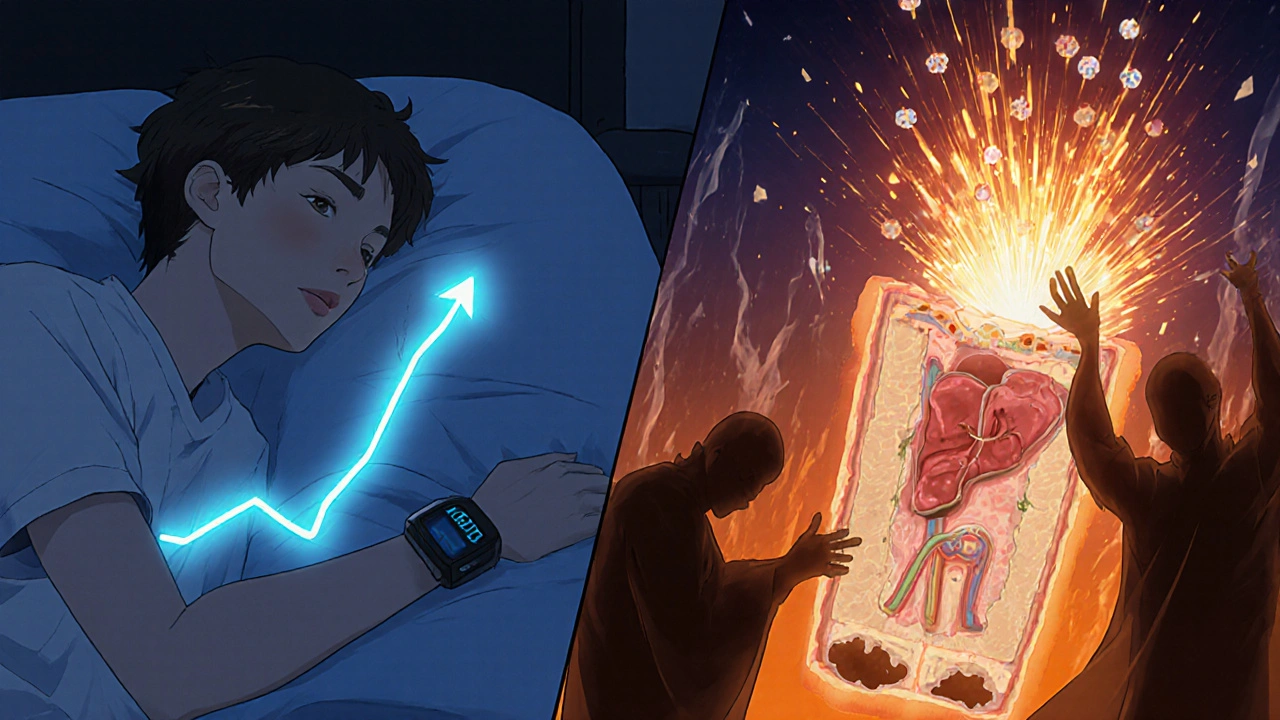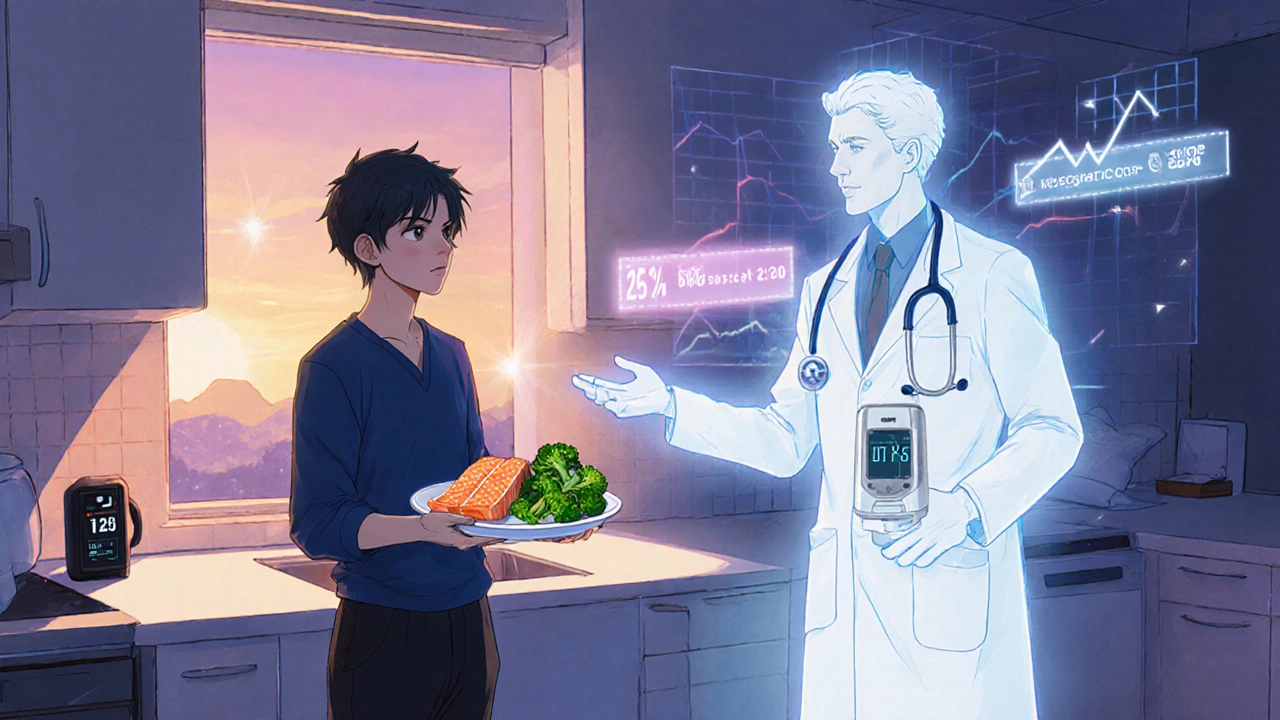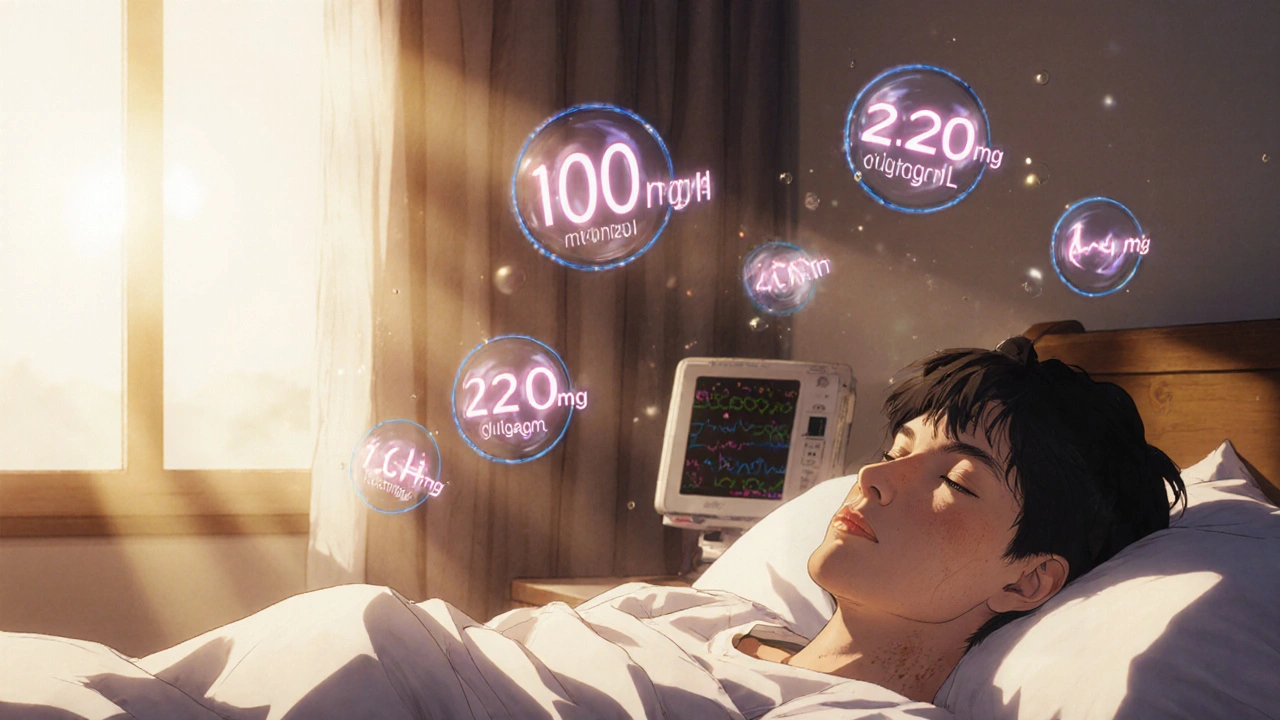Why Your Blood Sugar Spikes Every Morning
Ever wake up to a blood sugar reading that’s way higher than it was when you went to bed - even though you ate well the night before and took your meds? You’re not alone. About half of all people with Type 1 or Type 2 diabetes deal with this every day. It’s not because you ate too much carbs at dinner. It’s not because you forgot your insulin. It’s something called the dawn phenomenon.
This isn’t a mistake. It’s your body doing exactly what it’s supposed to do - just in the wrong way when you have diabetes. Between 3 a.m. and 8 a.m., your body naturally releases hormones like cortisol and growth hormone to prepare you for the day. These hormones tell your liver to pump out glucose so you have energy when you wake up. In someone without diabetes, the pancreas responds by releasing insulin to keep things balanced. But if you have diabetes, your body either can’t make enough insulin or can’t use it well. So instead of staying steady, your blood sugar climbs - sometimes by 50, 80, even 100 mg/dL overnight.
Dawn Phenomenon vs. Somogyi Effect: Know the Difference
Not every morning high is the dawn phenomenon. There’s another condition called the Somogyi effect that looks similar but happens for a totally different reason. The Somogyi effect happens when your blood sugar drops too low in the middle of the night (below 70 mg/dL), and your body panics. It releases stress hormones to raise blood sugar back up - but it overshoots. You wake up with high glucose, but it’s a rebound, not a natural rise.
So how do you tell them apart? Check your blood sugar at 3 a.m. for three nights in a row. If it’s low (under 70 mg/dL) and then spikes by morning, it’s Somogyi. If it’s normal or rising steadily from 3 a.m. onward, with no dip, it’s the dawn phenomenon. Most people who think they’re having rebound highs are actually dealing with the dawn phenomenon. In fact, studies show that 68% of morning highs are due to the dawn phenomenon, not the Somogyi effect.
What Happens in Your Body During the Dawn
Here’s what’s actually going on inside you between 3 and 8 a.m.:
- Around 3 a.m., cortisol levels start to rise - up to 50-100% higher than nighttime levels.
- Growth hormone surges, increasing by 300-500%, which triggers your liver to break down stored glycogen into glucose.
- Glucagon, another hormone, tells your liver to make even more glucose from scratch (gluconeogenesis).
- In a person without diabetes, insulin rises by 40-50% to handle this. But if you have Type 1 diabetes, your body makes almost no insulin. In Type 2, your cells don’t respond well to it.
- The result? Blood sugar climbs 10-15 mg/dL per hour, often hitting 180-250 mg/dL by 8 a.m.
This isn’t just inconvenient. Consistently high morning numbers can push your HbA1c up by 0.5 to 1.2 percentage points. That’s a 21% higher risk of nerve damage, kidney problems, and eye disease for every 1% increase in HbA1c, according to the UK Prospective Diabetes Study.
Real Symptoms - And Why They Matter
You might not feel anything at first. But as morning highs get worse, you’ll notice:
- Extreme thirst - 65% of people report this
- Needing to pee a lot - 78% deal with this
- Feeling tired, foggy, or drained - 82% say it hits them hard
- Blurred vision - 34% notice it right after waking
And if your glucose hits 250 mg/dL or higher? You’re at risk for diabetic ketoacidosis (DKA), especially if you have Type 1 diabetes. One study found that people with uncontrolled dawn phenomenon had over 3 episodes of DKA per 100 people each year. That’s not rare - it’s a real danger.

How to Manage It - Practical Steps That Work
There’s no one-size-fits-all fix, but these strategies have helped thousands of people bring their morning numbers down - safely.
1. Use a Continuous Glucose Monitor (CGM)
This isn’t optional anymore. If you’re still checking blood sugar with finger pricks, you’re flying blind. CGMs show you your glucose trend - not just one number. You can see exactly when your rise starts, how fast it climbs, and whether it’s truly dawn phenomenon. Dexcom G7, Abbott FreeStyle Libre 3, and Medtronic Guardian 4 are the most trusted systems. Endocrinologists say 85% of them won’t adjust treatment without CGM data.
2. Adjust Your Insulin (If You Use It)
If you’re on an insulin pump, you can program a higher basal rate between 3 a.m. and 7 a.m. Most people increase it by 20-30% during those hours. Studies show this cuts morning highs by 45-60 mg/dL on average.
If you’re on multiple daily injections, talk to your doctor about shifting your long-acting insulin to bedtime instead of dinner time. Some people benefit from switching from insulin glargine to degludec - it lasts longer and has a flatter profile overnight.
Automated insulin delivery systems (like Control-IQ or t:slim X2 with Control-IQ 3.0) are now the gold standard. They predict the dawn rise and start increasing insulin as early as 2 a.m. In trials, they reduced morning highs by 58-63%.
3. Change Your Evening Eating
What you eat at dinner matters more than you think. A high-carb meal before bed gives your liver extra fuel to turn into glucose overnight. The Joslin Diabetes Center found that cutting evening carbs to under 45 grams reduced morning spikes by 27%.
Instead of pasta, rice, or bread, try: grilled chicken with broccoli, salmon with asparagus, or a salad with lean protein and olive oil. If you’re hungry before bed, go for a small snack with protein and fat - like 1 tablespoon of peanut butter, a hard-boiled egg, or a small handful of almonds. Avoid anything with sugar or fast carbs.
4. Sleep Better - It’s Not Just About Hours
Getting 7-8 hours of sleep isn’t just good for your mood. Poor sleep increases morning glucose by 15-20 mg/dL, according to Sleep Medicine Reviews. Stress, late screens, and irregular sleep times all disrupt your hormones and make the dawn phenomenon worse.
Try this: Go to bed and wake up at the same time every day. Avoid screens 1 hour before bed. Keep your room cool and dark. Even small improvements in sleep quality can make a big difference.
5. Consider GLP-1 Medications
If you have Type 2 diabetes, your doctor might suggest a GLP-1 receptor agonist like semaglutide (Wegovy, Ozempic) or dulaglutide (Trulicity). Timing matters - taking it at night instead of in the morning helps blunt the dawn effect. The DURATION-8 trial showed evening dosing lowered morning glucose by 18-22 mg/dL.
What Doesn’t Work - And Why
Many people try to fix morning highs by skipping dinner, cutting carbs too low, or taking extra insulin at bedtime. But these can backfire.
- Skipping dinner leads to low blood sugar at night - which can trigger the Somogyi effect.
- Overdosing on insulin at night raises your risk of dangerous hypoglycemia, especially while sleeping.
- Ignoring CGM data and guessing based on morning numbers alone leads to mismanagement in 34% of cases, according to the American Association of Diabetes Educators.
Dr. John Buse from UNC put it bluntly: “Aggressive treatment without confirmation often causes more harm than good.” Always check your 3 a.m. glucose before changing anything.
What People Are Actually Doing - Real Stories
On diabetes forums, people share what works for them:
- One woman with Type 1 switched from two daily insulin shots to an insulin pump and programmed a 25% basal increase from 2:30 a.m. to 7 a.m. Her morning numbers dropped from 210 to 125.
- A man with Type 2 started eating a small bedtime snack of 15g protein and 5g fat (like cottage cheese with a few walnuts). His morning highs dropped by 32%.
- A teenager with Type 1 started using a CGM and discovered his rise started at 2 a.m. - not 4 a.m. His endocrinologist adjusted his pump settings earlier, and his HbA1c fell from 8.4% to 7.1% in 3 months.
But not everyone gets support. On the Type 1 Diabetes Exchange Forum, 78% of respondents said their doctors dismissed their morning highs as “poor diet.” That’s frustrating - and dangerous. The dawn phenomenon is real. You deserve a provider who understands it.

What’s Coming Next
The future of dawn phenomenon management is getting smarter. Researchers are testing dual-hormone systems that deliver tiny doses of pramlintide (a hormone that blocks glucagon) during the early morning hours. Early results are promising.
Genetic research from Oxford has found 7 gene variants linked to stronger dawn responses. In the next 5-7 years, we may see blood tests that tell you if you’re genetically prone to severe morning spikes - and tailor treatments before problems start.
Meanwhile, insulin manufacturers are developing once-weekly insulins like icodec that provide smoother overnight coverage. Early trials show 28% better morning control than daily insulins.
Start Here: Your 3-Step Action Plan
- Get a CGM if you don’t have one. If you can’t afford it, ask your doctor about insurance coverage or patient assistance programs.
- Check your blood sugar at 3 a.m. for three nights. Write down the numbers. Is it low? Normal? Rising?
- Based on those results, talk to your diabetes care team. Don’t change insulin doses on your own. Start with diet and sleep. Then consider tech or meds.
It’s not about perfection. It’s about progress. Even lowering your morning glucose by 30 mg/dL can make your whole day feel easier - and reduce your long-term risks.
What to Do If Your Morning Numbers Won’t Budge
If you’ve tried all the above and your morning glucose is still above 180 mg/dL most days:
- Ask for a referral to a certified diabetes care and education specialist (CDCES). They know how to interpret CGM trends and adjust regimens safely.
- Request a review of your insulin-to-carb ratios and correction factors - they may need fine-tuning.
- Consider a sleep study if you snore or feel exhausted despite getting 8 hours. Sleep apnea worsens insulin resistance.
Don’t give up. The dawn phenomenon is tough - but it’s manageable. With the right tools and support, you can wake up with stable numbers - and take back control of your day.

